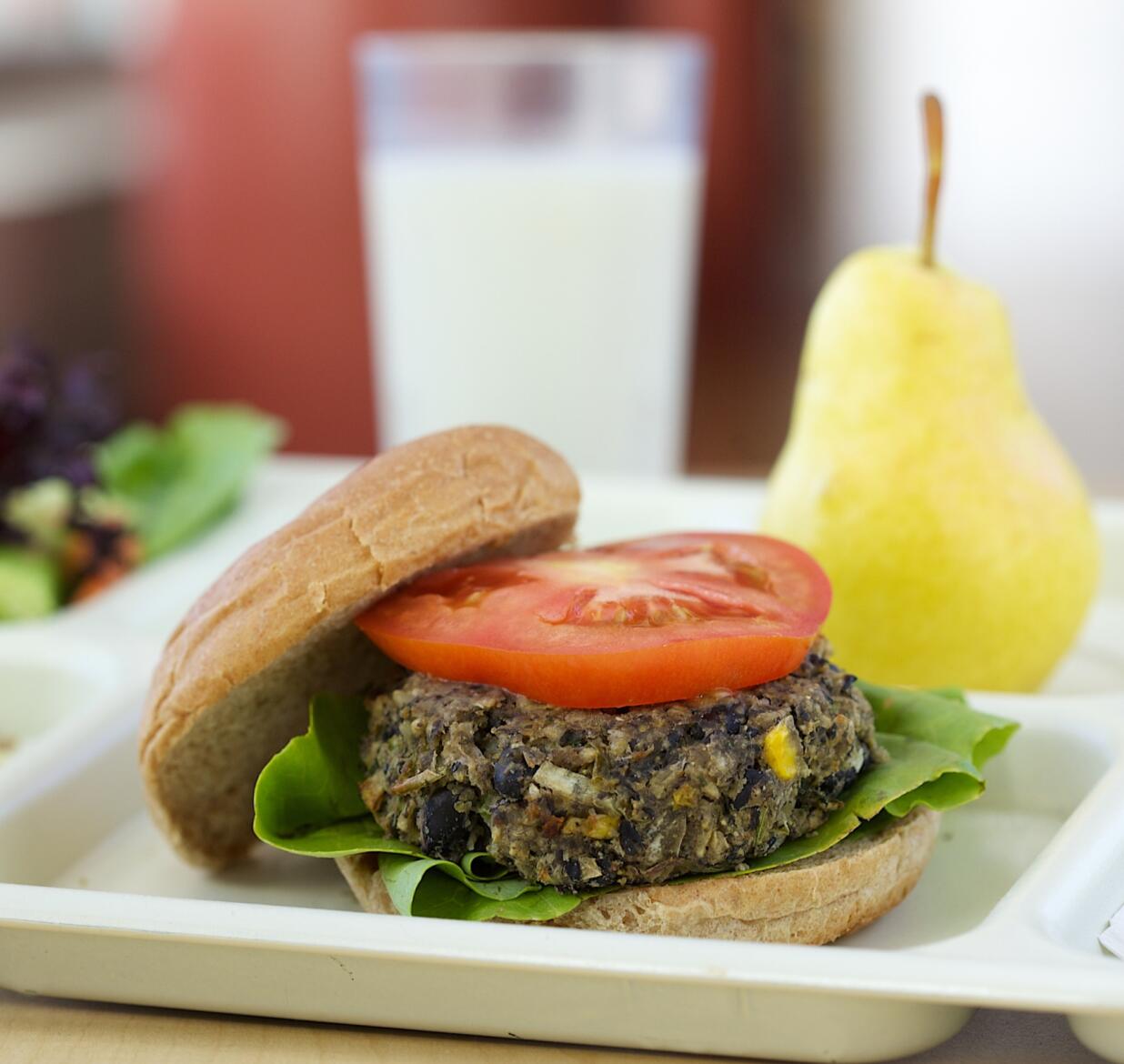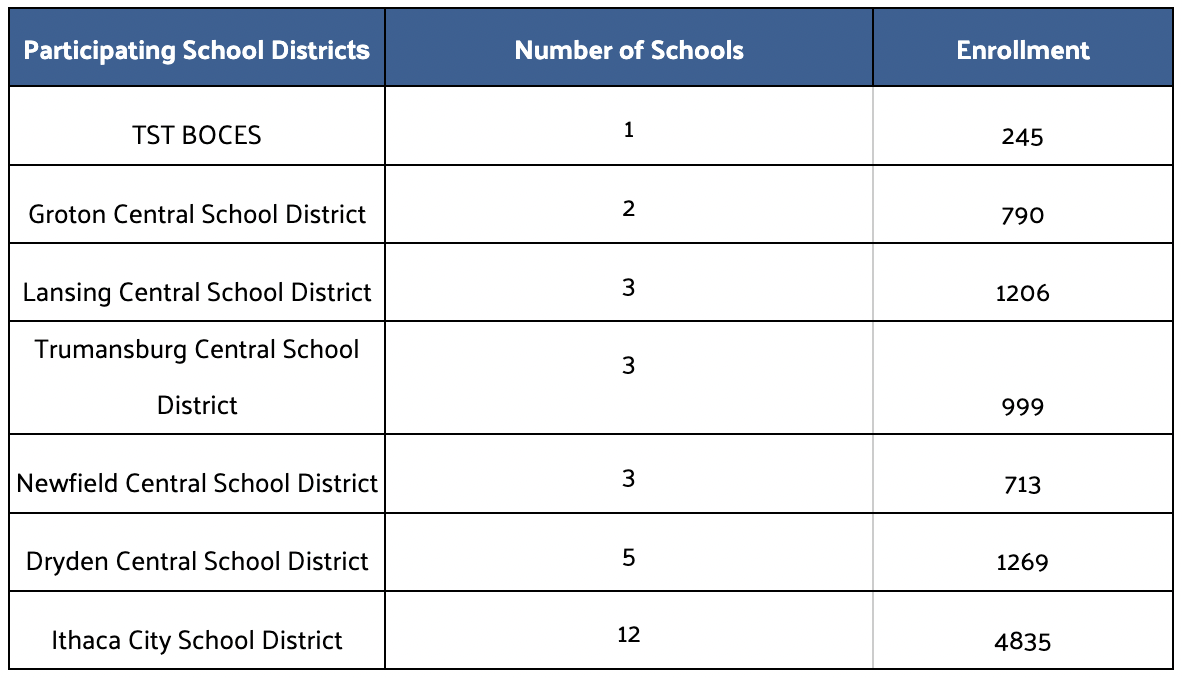
Supporting School Food Change in Tompkins County, New York
September 28, 2022 | By Imari Whalen
We recently met with school food teams in Tompkins County, New York, to develop individualized plans for their food programs. Learn how these plans were designed to serve as a strong foundation for the health and academic success of students across Tompkins County.
Serving scratch-cooked school meals made with whole, nutrient-rich ingredients has the power to support all students as they strive to meet their full potential each school day. Over the past three years, school food programs nationwide, such as those in Tompkins County, New York, masterfully navigated the additional strains imposed by the pandemic to simply keep students fed. As more opportunities for district-wide collaborations became available, the school food professionals in Tompkins County began making significant strides toward strengthening their programs by teaming up with neighboring districts.
Collaborative Efforts in Tompkins County
In September 2022, The Chef Ann Foundation (CAF) had the exciting opportunity to work with districts in Tompkins County to make their goal of increasing scratch cooking a reality. Prior to our involvement, the school food professionals in Tompkins County already expressed an incredible amount of enthusiasm and energy towards integrating more healthy, scratch-cooked food into their programs. Even while overcoming COVID-related obstacles, the seven teams of school food professionals collaborated regularly to explore new possibilities and to take action to improve the food in their districts.

Given their prior preparation and significant progress towards improving their districts’ food, it was evident that the seven teams were ready to take their innovative work a step further. With support from The Park Foundation and Tompkins Cortland Community College (TC3) Foundation, CAF’s Founder & President Chef Ann Cooper and Senior Director of Research and Assessment Anneliese Tanner invited the districts to join a comprehensive School Food Reboot Camp.
The program was structured to support the districts as they develop strategies for incorporating more local ingredients and scratch-cooked meals into their food programs. Over the course of two and a half days, the school districts received personalized resources, considerations, and recommendations to address the unique challenges faced by their school food staff.
Taking a Deeper Dive with SCALE
To kick off their participation in the School Food Reboot Camp, the districts completed our Scratch Cooking Assessment & Learning Evaluation (SCALE). Upon completion, each district received an in-depth report focusing on several components of their nutrition program: Food, Scratch Cooking, Facilities, Finance, Human Resources, and Marketing.
Using the recommendations from the SCALE reports, we facilitated two interactive training sessions and one workshop on strategic planning with the school food staff members. The results from SCALE were also used to develop individualized three-year strategic plans to help each program implement recommendations from the School Food Reboot Camp and increase scratch cooking. The initial SCALE score received by each district will serve as a baseline for measuring progress as the districts complete the assessment annually.
Increasing Scratch Cooking
During the training sessions, we were interested in learning how each district is currently incorporating scratch cooking into its food program. Consistently offering healthy, scratch-cooked meals gives districts the opportunity to create more equitable access to nutritious food for all students. While a majority of the districts reported offering scratch and speed scratch cooking, we found that the definitions of scratch and speed scratch cooking varied widely among the districts.


During the training sessions, we were interested in learning how each district is currently incorporating scratch cooking into its food program. Consistently offering healthy, scratch-cooked meals gives districts the opportunity to create more equitable access to nutritious food for all students. While a majority of the districts reported offering scratch and speed scratch cooking, we found that the definitions of scratch and speed scratch cooking varied widely among the districts.
We developed several recommendations to help the districts efficiently incorporate scratch-cooking into their programs, including:
Making funds available for K-12 menu planning & production software, along with providing staff with training on the software and effective use of production records
Creating a 4-6 week menu cycle across all school levels (elementary, middle, and high) to build efficiency and provide students with a variety of choices
Providing a limited number of entrees per school level to allow staff time to cook meals
Utilizing The Lunch Box for scratch recipes and sharing recipes across common menu planning software
Offering double-sided, self-serve daily salad bars across all site
Encouraging Local Procurement
Purchasing fresh, local ingredients is another great way for school food programs to impact the health of their students. Previously, the districts participated in a Harvest of the Month program in partnership with the Cornell Cooperative Extension. Districts were rewarded with additional meal reimbursements if at least 30% of the ingredients used in their meals were sourced from the state of New York. Although not all of the districts surpassed the 30% threshold, they saw the benefits of serving their students a wide array of locally grown foods.
Building on their earlier efforts, all of the districts are purchasing at least one type of local product for their food program. The districts noted that the main barriers to purchasing more local products are pricing, delivery delays, and distribution logistics. While the districts are incorporating local ingredients into their menus, only half of the participating food programs have a policy outlining the district’s local purchasing goals. After evaluating each district’s local procurement practices, we recommended that they establish a districtwide policy to keep track of the department’s visions and goals. We also recommended that the districts establish product standards to share with vendors to help educate them on what the district is looking for. Further phases of the program could include the schools coming together to increase local purchasing countywide.
Boosting Meal Participation

Monitoring meal participation is a useful strategy for school food programs to track their progress as well as areas for opportunity. Strategies for increasing participation, such as increasing local procurement and scratch cooking, can ensure that students are receiving fresh, high-quality meals and bolster food service revenue.
Generally, good average daily participation (ADP) for school breakfast is 30-35%, which all of the participating districts met. To ensure that all students have access and time to participate in breakfast and increase breakfast participation, we recommended that all districts work with their sites to practice Breakfast in the Classroom (BIC). For lunch, schools should aim for an ADP of 50%. A majority of the Tompkins districts met or exceeded this rate of participation. We recommended that districts use the Meal Count & Revenue Tracker to keep track of their progress.

Monitoring meal participation is a useful strategy for school food programs to track their progress as well as areas for opportunity. Strategies for increasing participation, such as increasing local procurement and scratch cooking, can ensure that students are receiving fresh, high-quality meals and bolster food service revenue.
Generally, good average daily participation (ADP) for school breakfast is 30-35%, which all of the participating districts met. To ensure that all students have access and time to participate in breakfast and increase breakfast participation, we recommended that all districts work with their sites to practice Breakfast in the Classroom (BIC). For lunch, schools should aim for an ADP of 50%. A majority of the Tompkins districts met or exceeded this rate of participation. We recommended that districts use the Meal Count & Revenue Tracker to keep track of their progress.
Building Support for School Food Programs
Mission and Vision Statement
Oftentimes, students, families, and school staff can learn more about the guiding principles of their school’s food program by taking a look at the program’s mission and vision statements. These statements serve to guide program decisions and inspire the community and stakeholders. For example, the school food departments at Groton and Ithaca created the following mission statements:
Groton Central School District: “Empower all students to reach their fullest potential and thrive in a diverse, ever changing world.”
Ithaca City School District: “Providing nutritious, healthy foods that children enjoy.”
To strengthen their presence within their schools and community, we recommended that the districts create both a mission & vision statement.
Creating Inclusive and Engaging School Food Programs
By serving culturally relevant menu items and providing translated materials, school districts can create meaningful connections between food, health, students, and the greater community. Building inclusive school food programs also encourages students to explore both new and familiar foods while at school. The districts were encouraged to explore other opportunities for increasing student engagement, including:
Continuing to highlight locally-grown foods through a Harvest of the Month series
Hosting tasting events
Leading cooking classes
Having students volunteer in their school’s garden
The Future of School Food in Tompkins County
At the end of the two and a half day program, we were inspired to see that the districts were motivated and ready to implement the strategies discussed throughout the workshop. Our team recognized that each of the districts in Tompkins County had varying strengths, obstacles, and opportunities for growth. More importantly, we saw that each district had leaders who were resilient and dedicated to improving their district’s food for their students. Through ongoing strategic planning and technical assistance provided by our team, the district food service departments can make significant strides in providing fresh, scratch-cooked meals to students across Tompkins County. Our partners at The Park Foundation and TC3 are committed to providing continued support to districts as they work to serve scratch-made meals. While these changes will take time, the commitment expressed by our partner organizations and districts to serving healthy, scratch-cooked meals to the students bodes well for the success of these programs in achieving their goals.







